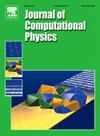Boundary integral methods for particle diffusion in complex geometries: Shielding, confinement, and escape
IF 3.8
2区 物理与天体物理
Q2 COMPUTER SCIENCE, INTERDISCIPLINARY APPLICATIONS
引用次数: 0
Abstract
We present a numerical method for the solution of diffusion problems in unbounded planar regions with complex geometries of absorbing and reflecting bodies. Our numerical method applies the Laplace transform to the parabolic problem, yielding a modified Helmholtz equation which is solved with a boundary integral method. Returning to the time domain is achieved by quadrature of the inverse Laplace transform by deforming along the so-called Talbot contour. We demonstrate the method for various complex geometries formed by disjoint bodies of arbitrary shape on which either uniform Dirichlet or Neumann boundary conditions are applied. The use of the Laplace transform bypasses constraints with traditional time-stepping methods and allows for integration over the long equilibration timescales present in diffusion problems in unbounded domains. Using this method, we demonstrate shielding effects where the complex geometry modulates the dynamics of capture to absorbing sets. In particular, we show examples where geometry can guide diffusion processes to particular absorbing sites, obscure absorbing sites from diffusing particles, and even find the exits of confining geometries, such as mazes.
复杂几何粒子扩散的边界积分方法:屏蔽、约束和逃逸
给出了具有复杂吸收体和反射体几何形状的无界平面区域中扩散问题的一种数值解法。本文的数值方法将拉普拉斯变换应用于抛物型问题,得到一个修正的亥姆霍兹方程,该方程用边界积分法求解。返回到时域是通过沿所谓的塔尔博特轮廓变形的拉普拉斯逆变换的正交来实现的。我们演示了由任意形状的不相交体构成的各种复杂几何形状的方法,这些几何形状上可以应用均匀狄利克雷边界条件或诺伊曼边界条件。拉普拉斯变换的使用绕过了传统时间步进方法的限制,并允许在无界域中扩散问题中存在的长平衡时间尺度上进行积分。利用这种方法,我们展示了屏蔽效应,其中复杂的几何形状调制捕获到吸收集的动态。特别是,我们展示了几何可以引导扩散过程到特定吸收点的例子,模糊扩散粒子的吸收点,甚至找到限制几何的出口,如迷宫。
本文章由计算机程序翻译,如有差异,请以英文原文为准。
求助全文
约1分钟内获得全文
求助全文
来源期刊

Journal of Computational Physics
物理-计算机:跨学科应用
CiteScore
7.60
自引率
14.60%
发文量
763
审稿时长
5.8 months
期刊介绍:
Journal of Computational Physics thoroughly treats the computational aspects of physical problems, presenting techniques for the numerical solution of mathematical equations arising in all areas of physics. The journal seeks to emphasize methods that cross disciplinary boundaries.
The Journal of Computational Physics also publishes short notes of 4 pages or less (including figures, tables, and references but excluding title pages). Letters to the Editor commenting on articles already published in this Journal will also be considered. Neither notes nor letters should have an abstract.
 求助内容:
求助内容: 应助结果提醒方式:
应助结果提醒方式:


